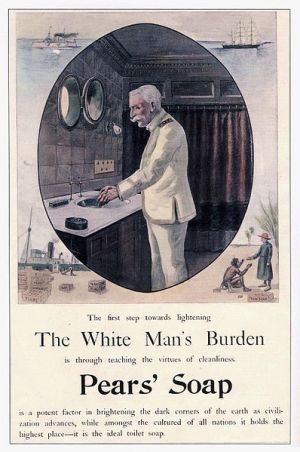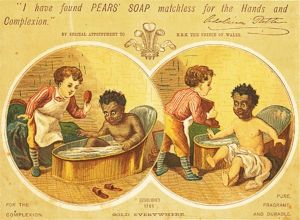Pears’ Soap
Pears’ Soap is a brand of soap by Andrew Pears that first produced and sold in 1807. Pears' Soap's factory was in Oxford Street in London, England. Pears' Soap was the world's first mass-market translucent soap. A. & F. Pears pioneered a variety of distribution and marketing developments under the direction of Thomas J. Barratt. In 1917, A. & F. Pears was bought by Lever Brothers, who later became Unilever. Pears products are actually only produced in India for international sale.[1]
History
Andrew Pears, the son of a farmer, was born in Mevagissey, Cornwall, around 1770 and moved to London around 1787. In 1789, he finished his apprenticeship, opened a barbershop on Gerrard Street in Soho, and started producing cosmetics. Pears' clientele included many affluent socialites who took pride in their appearance at the time, and Soho was a high-end suburban neighborhood at the time. Having a flawless white appearance was popular among the affluent of the time; tanned skins were synonymous with those who worked outdoors.
Pears discovered that his powders and creams were often used to conceal harm caused by the harshness of the soaps and other cosmetics products in use at the time, many of which contained arsenic or lead. Pears started experimenting with soap purification and finally developed a soft soap using glycerine and other natural ingredients.
Pears soap is now made in India by Hindustan Unilever, a company in which Unilever now has a 67 percent share.[2]
The Racist Advertisements
When looking at the advertising for Pears' Soap, which was first published in 1890, it is clear that the commercial contains the linguistic meaning "The White Man's Burden." The 'White Man's Duty' is often interpreted as a reason for white control over their colonies' primitive indigenous peoples. Pear's Soap is explicitly written in smaller letters that it should be used to disinfect black people in other countries.[3]
The ad can be divided into two sections, as seen in the picture. An oval-framed man and the backdrop in which the oval is set. A man is seen washing his hands in the middle, with a bar of Pear's Soap next to him. The porthole and white uniform indicate that the captain of a ship is being watched. Ships at sea and a beach can be seen in the distance. A white guy gives soap to a black person on the sand. The black man is knelt and appears to be pleading for the soap.
The second racial advertisement from Pears' Soap rhymes with the previous. When washing, the white boy hands the black boy a piece of Pears' Soap. Since using the soap, the black boy's body has turned white as he comes out of the water. He smiles for the first time as he sees his new white skin in the mirror. The soap is not only good for your skin, but also for your complexion, according to the text above the picture. The commercial does not claim that using the soap improves hygiene; rather, it claims that using it would help you ascend the social ladder by giving you a white complexion.
To top it off, the characters aren't accurate representations of real toddlers. The perception of a black person's complexion is exaggeratedly dark in Pear's ad, and it's combined with bright red lips to create a stereotype of how a traditional black person will appear and behave as a humorous impact. This gives the impression to white customers that black people are poor, dumb, or dirty. Quite the same. The white boy is dressed elegantly and has a relaxed expression, indicating that he is of a higher social status. The well-to-do white boy seems to be acting as a tutor to the other boy, based on his pose. Pears is saying that the first child, or white boys in general, are more intelligent about pears than those with darker skin, and that he should tell others about them.[4]
References
- ↑ Pears’ Soap. Retrieved December 29, 2020.
- ↑ Pears’ Soap. Retrieved December 29, 2020.
- ↑ Pears’ Soap: Washing the blacks white, esmee'sculturalhistory, 28 November 2016. Retrieved December 29, 2020.
- ↑ Pears’ Soap Advertisement Analysis, Visual Culture Blog. Retrieved December 29, 2020.


